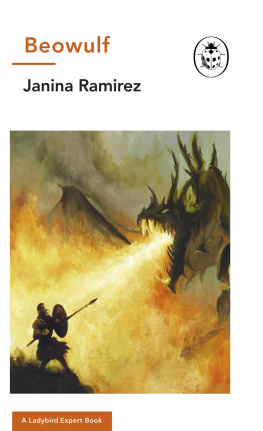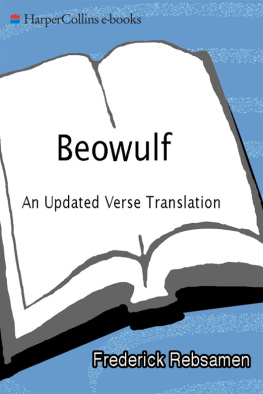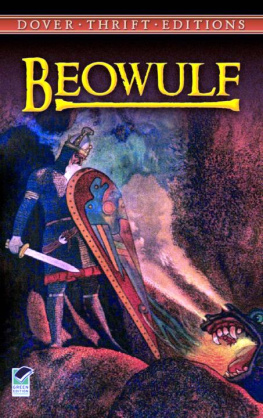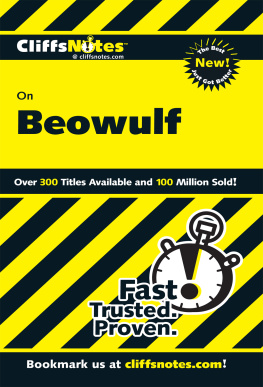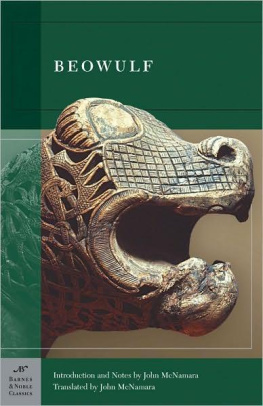Landmarks

BEOWULF AS CHILDRENS LITERATURE
Beowulf as Childrens Literature
EDITED BY BRUCE GILCHRIST AND BRITT MIZE
UNIVERSITY OF TORONTO PRESS
Toronto Buffalo London
University of Toronto Press 2021
Toronto Buffalo London
utorontopress.com
Printed in the U.S.A.
ISBN 978-1-4875-0270-6 (cloth)
ISBN 978-1-4875-1585-0 (EPUB)
ISBN 978-1-4875-1584-3 (PDF)
Library and Archives Canada Cataloguing in Publication
Title: Beowulf as childrens literature / edited by Bruce Gilchrist and Britt Mize.
Names: Gilchrist, Bruce D., editor. | Mize, Britt, editor.
Description: Includes bibliographical references and index.
Identifiers: Canadiana (print) 20210170417 | Canadiana (ebook) 20210170611 | ISBN 9781487502706 (cloth) | ISBN 9781487515843 (PDF) | ISBN 9781487515850 (EPUB)
Subjects: LCSH: Beowulf Adaptations. | LCSH: Childrens literature History and criticism. | LCSH: Children Books and reading History.
Classification: LCC PR1585 .B46 2021 | DDC 829/.3dc23
University of Toronto Press acknowledges the financial assistance to its publishing program of the Canada Council for the Arts and the Ontario Arts Council, an agency of the Government of Ontario.

Contents
Illustrations
Acknowledgments
Together we wish to express profound gratitude to Marijane Osborn, whose scholarship lighted the way for this project, and without whose early involvement, and even gifts of some books from her collection, it would never have become a reality. We are very grateful as well to Suzanne Rancourt at the University of Toronto Press for her encouraging belief in this books worth throughout its long development.
Britt would like to thank his colleagues at Texas A&M, especially Claudia Nelson, the students in his Beowulfs Afterlives graduate and undergraduate seminars, and all participants in the Medieval Studies Working Group and the Critical Child Studies Working Group. Thank you also to Ruby Perry-Mize for being an actual child and one willing to provide incisive commentary on many, many youth versions of Beowulf. Generous support for this project has been provided by Stanford Text Technologies, and by Texas A&M University through its Department of English and the Melbern G. Glasscock Center for Humanities Research.
Bruce wishes to acknowledge foremost Anna Smol, whose 1994 essay, Heroic Ideology and the Childrens Beowulf, is the first serious critical appraisal of the breadth and cultural work of adaptations of the poem for children. Her research of the holdings at the Osborne Collection of Early Childrens Books at the Toronto Public Library proves how vital archives of physical books are for understanding our reception of the past. Following her work, I then built my own collection, which was happily shared with my son Oscar in a great many bedtime readings of Grendel stealing towards Heorot and the dragon being pushed into the ocean. I also must acknowledge the extraordinary patience of our chapter contributors on the lengthy whale-road to publication, and, most deeply, my co-editor, Britt Mize, for his quietly compelling this book into the world with persistence and grace.
BEOWULF AS CHILDRENS LITERATURE
Introduction: Beowulf in and near Childrens Literature
BRITT MIZE
Recycling Beowulf is a booming business, in output if not always in commercial or aesthetic profit. At least eleven feature-length films have been Beowulf-themed, with more doubtful claims made for others. There are dozens of songs and musical compositions, many original poetic treatments, a slew of novels and shorter fiction (including representatives of the sci-fi, cyberpunk, and fantasy genres), around twenty graphic novel or comics versions, several video games, and three published board games.
Reworkings of Beowulf for children cover a full gamut of style and register. Some are graceful and sophisticated:
Through the dark night a darker shape slid. A sinister figure shrithed down from the moors ... toward the timbered hall, huge and hairy and slightly stooping ... Then it grasped the great ring-handle and swung open the door, the mouth of Heorot ... Grendel saw the knot of sleeping warriors and his eyes shone with an unearthly light.
Others come across as ponderously archaizing:
Dead the monster sank to the ground, and Beowulf ... saw at his feet the lifeless carcase of his foe ... He strode thither, and, seizing the corpse by the hideous coiled locks, shore off the head to carry to earth again.
And a few embrace silliness:
Wow! Not the Beowulf? The winner of Best Warrior in West Denmark three years in a row? marvelled the Dane.
Beowulf smiled and buffed his nails on his chain-mail shirt.
Not the Beowulf who ... was named Most Gorgeous Geat by Midgard Maiden Magazine?
Tis I! Beowulf struck a heroic pose.
Every stylistic choice, every illustration program, every enveloping paratext reflects decision-making about what kind of work a new version of the story should do for (and upon) young readers, in particular times and places, situated within their ecologies of opportunity, ability, and desire. Do childrens presentations of Beowulf educate? Entertain? Awe? Invite young people into more grown-up discourses? Do they encourage curiosity and exploration? Promote fixed values? Teach systems of social relations that adults find agreeable? Do they address children as they are presumed already to be, or urge young people to aspire to something unattained?
The answer to all of these questions is yes in a holistic view of the corpus, although the nature of the specific instance is always inflected by larger forces that shape adult investment: trajectories of nationalism; reforms in education like those in nineteenth-century Denmark and the twentieth-century United States; epoch-making trends and events in popular literary culture like the Tolkien phenomenon and Heaneys Beowulf translation. Nor has the production of childrens Beowulf engagements, though large in volume, had a constant rate, and its ebbs and flows prove that the motivation to make a youth adaptation in the first place is no less responsive to its social moment than are the strategies used in doing so. Every aspect of the practice of accommodating such a monument of traditional literary history to youth readers, both in its chronological rhythms and its methods, deserves serious investigation.
But scholarly interest in childrens adaptations of canonical literature has not matched the market and library presence of such adaptations. As Anja Mller points out in her introduction to the only whole book dedicated to the remaking of venerated adult literature for younger readers, the studies that do exist have tended to focus narrowly on individual cases rather than taking up larger questions of theory and method. Yet adaptations of works originally intended for adults are hardly a negligible part of the landscape of childrens literature. Bookstores stock an ample selection, and the catalogues of most publishers of youth literature include some retellings of classics, if not a whole series of them. The disparity of production and public demand with critical acknowledgment could imply merely a prevailing scholarly opinion that the adaptation of adult literature does not normally result in high-quality childrens books. Such a view may also be joined with a valid scepticism, among thoughtful observers of cultural and educational paradigms, as to whether perpetuating an old-fashioned literary canon is a project childrens literature should invest in.


